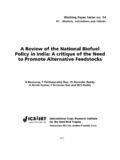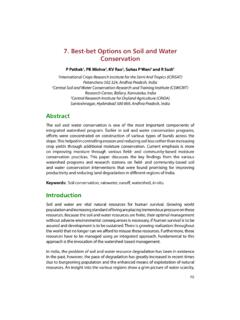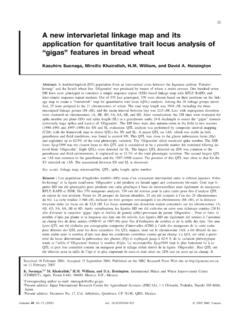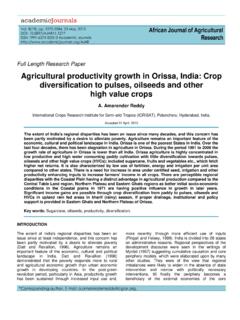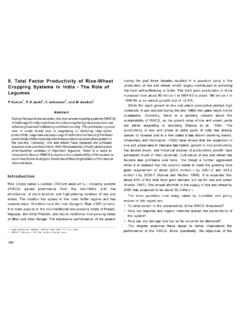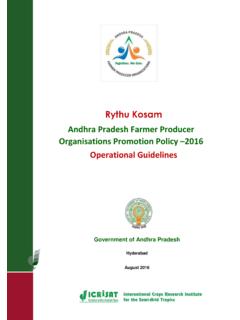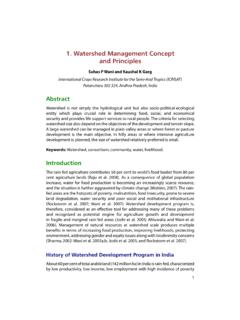Transcription of MICROENCAPSULATION TECHNOLOGY: A REVIEW
1 86 MICROENCAPSULATION TECHNOLOGY: A REVIEWA. POSHADRI and APARNA KUNAN utriplus, International Crops Research Institute for Semi-Arid Tropics, HyderabadPost Graduate & Research Centre,ANGR Agricultural University, ANGRAU 38(1)86-102, 2010 ABSTRACTThe development of new functional foods requires technologies for incorporating health promotingingredients into food without reducing their bioavailability or functionality. In many cases, microencapsulationcan provide the necessary protection for these compounds. Microcapsules offer food processors a means toprotect sensitive food components, ensure protection against nutritional loss, utilize sensitive ingredients,incorporate unusual or time-release mechanisms into the formulation, mask or preserve flavors/aromas andtransform liquids into easy to handle solid ingredients.
2 Various techniques cab be employed to formmicrocapsules, including spray drying, spray chilling or spray cooling, extrusion coating, fluidized-bed coating,liposomal entrapment, lyophilization, coacervation, centrifugal suspension separation, cocrystallization andinclusion complexation. This article describes the recent and advanced techniques of release of food ingredients at the right place and the right time is a key functionality that can beprovided by MICROENCAPSULATION . Timely and targeted release improves the effectiveness of food additives,broadens the application range of food ingredients, and ensures optimal dosage, thereby improving the costeffectiveness for the food ID: there is a trend towards a healthier way of living, which includes a growingawareness by consumers of what they eat and what benefits certain ingredients have inmaintaining good health.
3 Preventing illness through diet is a unique opportunity to useinnovative functional foods (Hilliam, 1996 and Sheehy and Morrissey, 1998).Microencapsulated products often present new challenges to food product developers. Existingingredients that are incorporated into food systems slowly degrade and lose their activity, orbecome hazardous, by propagating a chain of oxidation reactions. Ingredients also reactwith components present in the food system, which may limit bioavailability, or change thecolour and taste of the product.
4 In many cases, MICROENCAPSULATION can be used to overcomethese challenges. MICROENCAPSULATION is a technology that may be useful for generatingsmall particles that aggregate into thin layers. The simplest of the microcapsules consist ofa core surrounded by a wall or barrier of uniform or non-uniform thickness. The thickness ofthe coat ranges from several to hundreds of micrometres ( mm) and protects againstdegradative chemical processes (Rodrigues and Grosso, 2008). MICROENCAPSULATION is defined as a process in which tiny particles or droplets aresurrounded by a coating or embedded in a homogeneous or heterogeneous matrix, to give87small capsules with many useful properties .
5 MICROENCAPSULATION can provide a physical barrierbetween the core compound and the other components of the product. It is a technique bywhich liquid droplets, solid particles or gas compounds are entrapped into thin films of a foodgrade microencapsulating agent. The core may be composed of just one or several ingredientsand the wall may be single or double-layered. The retention of these cores is governed bytheir chemical functionality, solubility, polarity and volatility. Shahidi and Han (1993) proposedsix reasons for applying MICROENCAPSULATION in food industry: to reduce the core reactivitywith environmental factors; to decrease the transfer rate of the core material to the outsideenvironment; to promote easier handling; to control the release of the core material; to maskthe core taste and finally to dilute the core material when it is required to be used in veryminute amounts.
6 In its simplest form, a microcapsule is a small sphere with a uniform wallaround it. The material inside the microcapsule is referred to as the core, internal phase orwall, whereas the wall is sometimes called shell, coating, wall material or , the core may be a crystalline material, a jagged adsorbent particle, an emulsion,a suspension of solids or a suspension of smaller has many applications in food industry such as to protect,isolate or control the release of a given substance which is of growing interest in manysectors of food product development.
7 Converting a liquid into a powder allows many alternativeuses of ingredients. One of the largest food applications is the encapsulation of flavours(Shahidi and Han, 1993).The objective of this paper is to REVIEW the state of the art techniques ofmicroencapsulation of food ingredients by different processes and present necessary theoreticaland practical information on these processes. The influence of processing technology andmatrix materials used on the stability and bioavailability of these ingredients is also of microcapsulesMost microcapsules are small spheres with diameters ranging between a fewmicrometers and a few millimeters.
8 However, many of these microcapsules bear littleresemblance to these simple spheres. In fact, both the size and shape of formed microparticles depend on the materials and methods used to prepare them. The different types ofmicrocapsules and microspheres are produced from a wide range of wall materials likemonomers and/or polymers (King, 1995; Shahidi and Han, 1993). Depending on the physico- chemical properties of the core, the wall composition and the MICROENCAPSULATION techniqueused, different types of particles can be obtained (Fig.)
9 1): A simple sphere surrounded by acoating of uniform thickness; A particle containing an irregular shape core; Several coreparticles embedded in a continuous matrix of wall material; Several distinct cores within thesame capsule and multi walled TECHNOLOGY88 POSHADRI and APARNAM icroencapsulation TechniquesEncapsulation of food ingredients into coating materials can be achieved by severalmethods. The selection of the MICROENCAPSULATION process is governed by the physical andchemical properties of core and coating materials and the intended application of foodingredients.
10 The MICROENCAPSULATION processes that are used to encapsulate food ingredientsare given in Table 1, which outlines various methods used for the preparation ofmicroencapsulated food systems. Sophisticated shell materials and technologies have beendeveloped and an extremely wide variety of functionalities can now be achieved throughmicroencapsulation. Any kind of trigger can be used to prompt the release of the encapsulatedingredient, such as pH change (enteric and anti-enteric coating), mechanical stress,temperature, enzymatic activity, time, osmotic force, etc.
